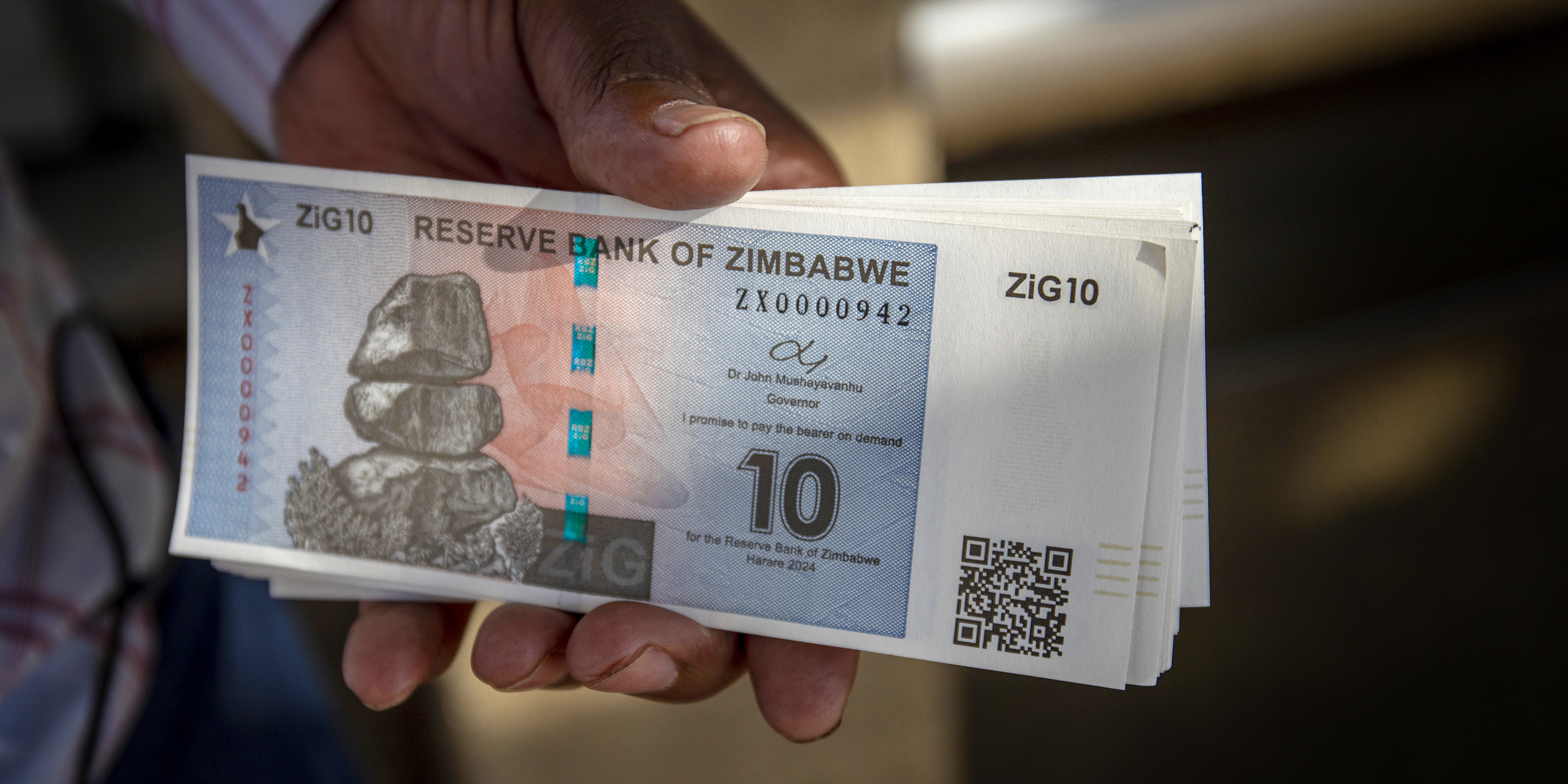Zimbabwe continues to defy the laws of economic gravity, with interest rates going up and the value of the currency going down.
On Friday, 27 September, the country’s central bank devalued its gold-backed ZiG -currency — short for Zimbabwe Gold — by nearly 43%, bringing it more in line with what it was fetching on the black market. According to Bloomberg, the currency went from 14.0/dollar to 24.4.
“While this is a positive step, it is unlikely to be a one-time adjustment. The country’s wide current account and fiscal deficits, along with limited access to external capital markets, will continue to place significant pressure on the currency,” Oxford Economics Africa said in a commentary about the move.
It’s positive, I suppose, because it’s a more realistic value. In a dysfunctional economy and failed state, the black market rate for a currency is usually a better reflection of its value.
The Reserve Bank of Zimbabwe also hiked its benchmark policy rate on Friday from 20% to 35%.
The bank did not come right out and say that it was making the ZiG sag.
Reserve Bank Governor John Mushayavanhu was quoted by Bloomberg as saying that the bank was taking measures to curb inflation, including allowing “greater exchange rate flexibility, in line with the increased demand for foreign currency in the country”.
You know things are bad when…
You know your economy is completely screwed when you raise interest rates sharply and simultaneously devalue your currency.
This is not how things typically play out.
It’s instructive to compare this unfolding debacle with what is happening in South Africa on the currency and monetary policy front.
On 19 September 2024, the South African Reserve Bank (Sarb) cut its key repo rate by 25 basis points to 8.0%, and the rand has extended its gains so far this year since then. The rand in early trade on Monday, 30 September, hit 17.07/dlr, around 20-month highs with a move below 17.0/dlr clearly on the cards.
There are a couple of things that explain this state of affairs.
For one, the bank’s move came the day after an even bigger 50 basis point cut by the US Federal Reserve, which significantly widened the interest rate differential between the greenback and the rand. This “carry trade” benefits the rand as traders seek profits from the higher-yielding currency.
Another key factor at play here is the simple fact that South Africa has access to global financial markets and Zimbabwe pointedly has not had this option since 1999, when it defaulted on its debts.
Stark political contrasts
The two countries also offer stark political contrasts. The ANC has not gone the ruinous route of Zimbabwe’s ruling Zanu-PF — stealing elections and/or ruining the agricultural base through ill-conceived land seizures.
When the ANC’s majority was slashed to 40% in the May elections, the party accepted the outcome and went on to form a Government of National Unity (GNU) with the opposition DA and other parties.
The prospects of real structural reforms have boosted South Africa’s economic prospects, and the end of the rolling nationwide power cuts since March have lifted the outlook for economic growth.
Zanu-PF is largely incapable of pursuing meaningful economic reforms because the party remains the vehicle of enrichment for a predatory elite.
So the authorities stumble from one fiasco to another in their bid to have a stable currency that the public and investors can have faith in.
Sixth attempt at currency reform
Launched in April, the ZiG represents Zimbabwe’s sixth attempt at currency reform since 2009. Harare dumped its currency in 2009 in the face of hyperinflation that saw the central bank’s printing press cranking out 100 trillion Zimbabwe dollar notes — that’s 14 zeros. Prices would rise between the time you walked into a shop and got to the counter to pay for your goods.
For a decade, Zimbabwe’s economy was officially “dollarized”. As Ecuador has discovered, dollarization provides a haven for money laundering and smuggling — criminals covet the greenback above all else — and in Zimbabwe’s case a gangster state went into full Godfather mode.
Zimbabwe then attempted to relaunch its currency in 2019 and it was a complete dud.
So now we have the ZiG, which is backed by gold at a time when the precious metal has been on an absolute tear. It is currently around record highs and just shy of a run to a new peak of $2,700 an ounce.
But even gold’s record run has not been able to prop up the ZiG. It is the chronicle of a currency collapse foretold.
The ZiG has also pointedly been circulating with other foreign currencies, which is hardly a ringing vote of confidence. A proper currency should be the only show in town.
The ZiG began to feel the heat in August as surging food import prices began to bite in the wake of a scorching drought unleashed by the El Niño weather pattern. This has left millions of Zimbabweans in need of food aid.
And while gold is shining at the moment, Bloomberg reports that lower prices for other commodities have hit dollar export earnings. It’s a perfect storm but one that could be weathered if Zimbabwe’s many governance challenges were addressed.
But they have not been, and so you can expect the ZiG to eventually follow Zimbabwe’s other attempts at “currency reform” into the dustbin of history. DM





